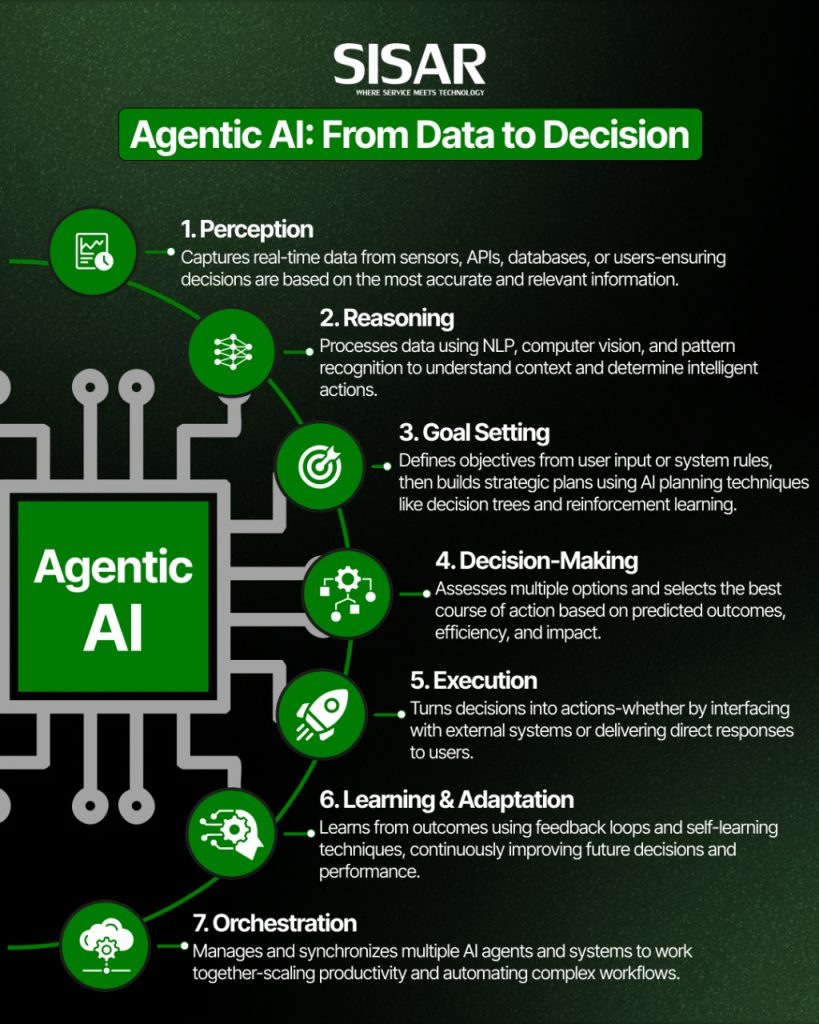Agentic AI refers to intelligent systems capable of independently pursuing and completing tasks aligned with specific goals. Unlike traditional AI—which often functions within predefined boundaries and depends heavily on human direction—agentic AI mimics human-like autonomy. It makes decisions, adapts to new information, and orchestrates actions with minimal supervision.
At the core of agentic AI are AI “agents”: specialized models that understand objectives, reason through problems, and act in real time. When combined in multi-agent systems, these agents collaborate to achieve complex outcomes. The term “agentic” highlights their independence and purpose-driven nature.
Agentic AI builds upon generative AI (GenAI), extending its capabilities beyond content creation. While GenAI might write a security report or generate code snippets, agentic AI could go further—running tests, deploying patches, monitoring outcomes, and adjusting behavior based on results.
How Agentic AI Works From Data to Decision?

Most agentic AI systems follow a structured lifecycle, allowing them to operate autonomously while learning from experience:
Perception
Agentic AI begins by gathering data from its environment through various sources such as sensors, APIs, databases, or direct user interactions. This ensures the system operates with the most current and relevant information, enabling accurate analysis and decision-making.
Reasoning
Upon data collection, the AI processes this information to extract valuable insights. Utilizing techniques like natural language processing (NLP), computer vision, and other advanced AI methodologies, it interprets queries, detects patterns, and gains a deeper understanding of the context. This cognitive processing allows the AI to assess the situation and determine the appropriate actions to take.
Goal Setting
Based on predefined objectives or user inputs, the AI sets clear goals. It formulates strategies to achieve these goals, leveraging decision trees, reinforcement learning, or other advanced planning algorithms to guide its approach and decision-making process.
Decision-Making
The AI evaluates various possible actions, selecting the most optimal course based on a range of factors, including efficiency, accuracy, and the predicted outcomes. It employs probabilistic models, utility functions, or machine learning-driven reasoning to assess and choose the best action to achieve the desired results.
Execution
Once a decision is made, the AI takes action, whether by interacting with external systems (such as APIs or robotic systems) or providing responses directly to users. This step translates the decision into tangible results.
Learning and Adaptation
Following execution, the AI evaluates the outcome and gathers feedback. It uses reinforcement learning or self-supervised learning techniques to refine its decision-making strategies over time. This continuous learning process enhances the system’s ability to handle similar tasks more effectively in the future.
Orchestration
AI orchestration involves the management and coordination of systems and agents working together to achieve a common goal. Orchestration platforms automate workflows, track progress toward task completion, manage resources, and monitor data flow and memory usage. In well-designed systems, multiple agents—ranging from dozens to potentially thousands—can collaborate seamlessly, optimizing productivity and ensuring efficient task management.
Unlocking the Power of Agentic AI
Agentic AI offers transformative capabilities that enable organizations to automate complex tasks, improve decision-making, and respond faster to emerging threats.
Autonomy at Scale: Agentic AI agents can independently execute multistep processes—like incident response or compliance tasks—without manual oversight, enabling consistent performance across large-scale environments.
Proactive Intelligence: By integrating large language models (LLMs) with real-time data sources such as APIs, sensors, and logs, agents can detect anomalies and take action before issues escalate.
Specialization: Each agent can be trained or configured for a specific task—such as threat modeling, policy auditing, or phishing detection—ensuring expert-level focus and speed.
Adaptive Learning: Feedback loops help agents refine their behavior over time, making the system more accurate, resilient, and aligned with organizational goals.
Natural Interfaces: Built on LLMs, agentic systems support conversational interfaces, making interactions intuitive for users without deep technical backgrounds.
Revolutionizing Industries with Autonomous Intelligence
Agentic AI is already reshaping operations across industries:
- Finance: Autonomous trading bots analyze market conditions and execute trades based on predictive analytics.
- Healthcare: Clinical agents adjust care plans in real time based on patient data and new research.
- Supply Chain: AI agents optimize procurement, routing, and inventory management autonomously.
- Autonomous Vehicles: Real-time navigation agents process GPS and sensor data to enhance decision-making.
- Cybersecurity: Agents detect, investigate, and respond to threats—often before human analysts can react.
Deep Dive: Cybersecurity Transformation
Security Operations Centers (SOCs) face growing threats, expanding attack surfaces, and overwhelming data volumes. Traditional tools are reactive and resource-intensive. Agentic AI offers a powerful shift toward intelligent, autonomous defense.
Key Applications in SOCs:
- Autonomous Threat Remediation:
Darktrace uses AI to autonomously detect and contain threats in real time. In one case, its system halted a ransomware attack at a major financial institution, highlighting how agentic AI can boost speed and precision in cyber defense.
For instance, the Darktrace Cyber AI Analyst has demonstrated a 92% reduction in the time required to investigate threats, enabling faster and more precise threat mitigation. Source: Darktrace Cyber AI Analyst Investigates Threats at Machine Speed - Alert Fatigue Reduction:
IBM’s QRadar uses AI-driven threat intelligence to streamline alert triage, helping SOC teams focus on critical incidents. A healthcare provider using the platform saw improved response efficiency, underscoring its value in reducing alert fatigue and boosting analyst productivity.
Additionally, IBM’s AI-powered cybersecurity solutions have been shown to accelerate alert investigations and triage by an average of 55%, enhancing the efficiency and effectiveness of security teams. Source: Artificial Intelligence (AI) Cybersecurity | IBM - Operational Efficiency:
Splunk’s Phantom, an automation and orchestration platform, streamlines incident response and compliance reporting by automating complex workflows. A global retail company leveraged Phantom to correlate logs from thousands of devices, significantly cutting down manual effort and boosting operational efficiency. This allowed their security team to shift focus from routine tasks to more strategic threat analysis and response.
Splunk reports that their customers have automated up to 75% of manual security tasks, leading to faster incident detection and lower operational costs.
The Strategic Edge in Cybersecurity`
Faster Detection and Containment (MTTD and MTTC)
By autonomously analyzing alerts and initiating immediate responses, agentic AI dramatically reduces Mean Time to Detect and Contain threats—minimizing downtime and impact.
Improved Accuracy and Fewer False Positives
AI agents continuously learn from context and outcomes, allowing them to prioritize real threats over noise and reduce alert fatigue for SOC analysts.
Efficient Scaling of Security Operations
Agentic systems can process and respond to thousands of signals in parallel, allowing organizations to scale security coverage without increasing headcount.
Cost Reduction Through Automation
By automating routine tasks like log correlation, ticket routing, and compliance reporting, agentic AI lowers operational costs and frees human talent for high-value work.
Guarding Against Agentic AI Risks
Agentic AI is powerful—but not without risks:
Governance and Accountability: Clear frameworks must define who is responsible when agents act independently.
Reliability and Alignment: Actions must consistently reflect organizational goals and ethical standards.
Compliance and Regulation: Data handling and decision-making must adhere to legal requirements, particularly in finance and healthcare.
Unintended outcomes—like an agent over-optimizing for speed and skipping security steps—must be anticipated and mitigated with strong oversight and testing.
Building the Right Foundation for Agentic AI
Before deploying agentic AI, organizations must evaluate readiness:
Complexity of Tasks: Simple automation may need one agent; complex workflows may require orchestration of many.
- Data Privacy & Security: Ensure robust encryption, access controls, and compliance features.
- Ease of Use: Tools like CrewAI offer no-code solutions, while LangGraph supports custom agent orchestration.
- Integration Capabilities: Verify compatibility with your APIs, databases, and enterprise software.
- Performance & Scalability: Test how the system behaves under real-world loads and evolving requirements.
Redefining Cybersecurity with Autonomy
Agentic AI marks a paradigm shift from passive tools to autonomous, goal-driven systems. In cybersecurity, it enables SOCs to transition from reactive responders to proactive defenders—enhancing accuracy, speed, and efficiency.
With thoughtful implementation, clear governance, and the right frameworks, agentic AI can help organizations stay ahead of adversaries, reduce operational burden, and secure digital environments at scale.
The future of cybersecurity is autonomous. Now is the time to explore what agentic AI can do for your defense strategy.
Transform Your Security
Ready to elevate your cybersecurity game with the power of agentic AI? SISAR’s services are designed to seamlessly integrate cutting-edge technology into your security operations, transforming your SOC from reactive to proactive. From AI-powered threat detection to autonomous remediation, our solutions empower your team to stay ahead of the curve.
Explore how SISAR can future-proof your cybersecurity strategy and help you tackle today’s most pressing challenges. Let’s build a more secure tomorrow, together. Reach out to us today to get started!







